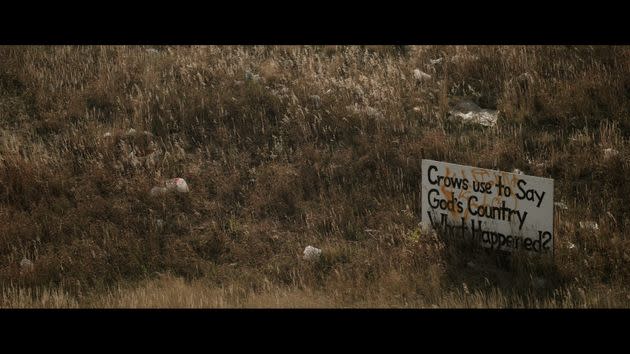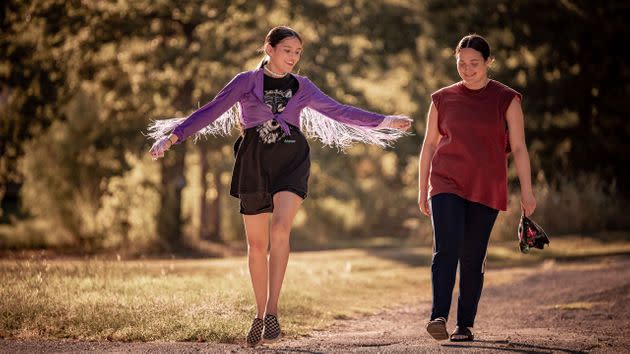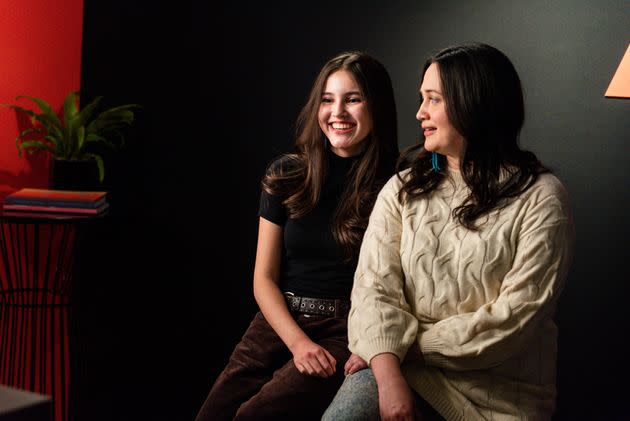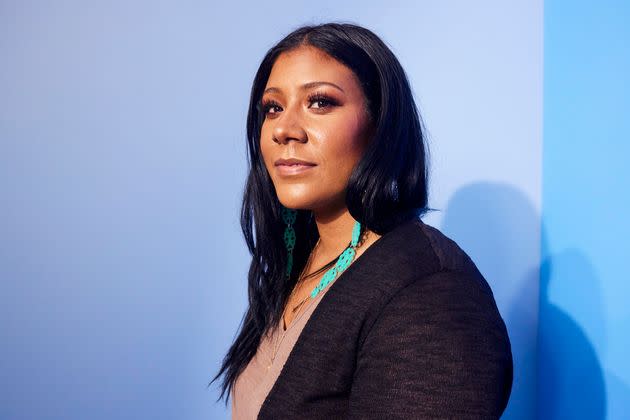Native Femicide Is A Prevalent Truth, And 2 Sundance Premieres Offer A Human Look At It

A question that often comes to mind for many underrepresented filmmakers is whether or how the reality of systemic racial trauma and abuse shows up in narratives centering on their people. Native storytellers are no exception, particularly at Sundance, a festival that built its mission around supporting their work and celebrating the humanity of the ancestral landowners.
Quiet as it’s too often kept in American media coverage, Indigenous communities continue to experience rampant domestic violence, unsolved murders and disappearances, as well as drug and alcohol addiction — much of which is due to the lasting effects of colonization.
So, what happens when you’re a Native storyteller nurturing your next project and looking for a way to invite audiences into Indigenous communities through the power of cinema but also grappling with the aforementioned question above of what role, if any, should trauma play in it?
Perhaps a scene to consider that question is in “Murder in Big Horn,” the Showtime-acquired docuseries helmed by directors Razelle Benally and Matthew Galkin that investigates the prevalence of MMIW (murdered and missing Indigenous women) in Montana. In it, a young woman recalls to Native journalist Luella Brien the last time she saw her missing friend.

"Murder in Big Horn" offers a human look at a centuries-old crisis within the Indigenous community.
Without a tear, she plainly details their location, the events of that evening, and calling out in vain to her friend in the dark of the night. As if it were a regular Tuesday evening. The moment strikes a chord because it underscores how common this reality is, to the point where one could become nearly phlegmatic about it.
Even Benally, who spoke candidly about this issue the day before the series’ Sundance premiere, remembers coming across her own family member’s name on the missing person’s registry while doing research for the show.
“My whole lived experience as a brown Native girl — you just understand the fear of something happening to you,” she told HuffPost.
When Benally discovered that her own niece was affected by this, she recalls “having to call family and be like, ‘where is she?’ ‘Oh, she’s been gone for the last 10 days. We don’t know where she is. We had no choice but to file a missing person’s report on her.’”

A somber still frame from "Murder in Big Horn."
Though her niece was thankfully found alive, the pervasiveness of this kind of story remains. “And that can upend your entire day, week, month,” Benally added.
So, it becomes impossible to ignore them on screen, a platform where the truth can’t be hidden easily — and shouldn’t be. But it all comes down to how the artist approaches it, the story’s authenticity, and the filmmaker’s appreciation for the humanity at the center of it. That’s what makes “Murder in Big Horn” so compelling.
And to think, Benally was initially unsure that she could take on the three-episode docuseries, partly because of its heaviness.
“I never thought I’d do something regarding MMIW because it is such a part of every day of being a Native woman,” she said. “It has always been such a sensitive and large-scale, complex topic that I always felt like I lack the confidence to do justice to the story in a broad form.”
What is critical in “Murder in Big Horn,” and what Benally and Galkin do so well, is examining the complexities of Indigenous identity. That includes talking to the family members impacted by this crisis and exploring the role colonialism plays in its history and present and the people, particularly the women, who fight to protect their humanity.

Journalist Luella Brien relentlessly searches for the truth in "Murder in Big Horn."
So that when a girl or woman goes missing, people across all identities, including law enforcement officers and media, treat it with the respect and urgency it deserves.
Benally and Galkin shot the series on the land where the surviving families still live to build trust and bond with the community. And it shows as you watch “Murder in Big Horn.” The people who reside on the land were and are, as anyone else is, flawed but worthy of compassion and determined to find the truth.
“We focus on the human side and bring back to life some of these young women that are no longer with us and honor their stories because they can’t speak for themselves anymore,” Benally said.
“That’s what I wanted to do instead of making a documentary filled with statistics and so much sadness.”

From Left: Roki (Isabel Deroy-Olson) and her aunt Jax (Lily Gladstone) share a tender moment in "Fancy Dance"
You could say the same about “Fancy Dance,” director Erica Tremblay’s narrative feature that premiered at Sundance this year.
It grounds real-world themes like missing Native women and substance abuse issues, often introduced by white settlers, in a fictional story about the relationship between a queer Indigenous woman named Jax (Lily Gladstone) and her niece Roki (Isabel Deroy-Olson).
Before the start of the narrative, Roki’s mother, Tawi, goes missing. Without any other family to truly depend on, Jax quickly takes Roki in and cares for her while conducting a relentless, one-woman search for Tawi.
At the same time, Roki prepares to attend the traditional Native powwow, where she and others in the community can dance, sing and honor the culture. And she expects her mom to show up.
“Fancy Dance” is, at its core, a story about the complicated relationship between an aunt and her niece. But Tremblay, with co-screenwriter Miciana Alise, immediately knew that for audiences, especially Natives, to connect to these characters, they had to be rooted in reality.
Tremblay had been studying the nearly extinct Cayuga language in Canada when she learned that the words for mother and auntie translated to mother and little mother, a fact referenced in “Fancy Dance,” which made her think about her relationship with her nieces and nephew.
“It really started as this: How can we frame a beautiful story of matrilineal kinship through the story of an aunt and a niece?” Tremblay said. “And very early on, the themes of MMIR [missing and murdered Indigenous relatives] and foster care challenges were things that I wanted to be burning in the background.”
She soon messaged Alise to help write the script, and together as Native women — Tremblay is half white on her dad’s side, and Alise is half Black on her father’s side — they brought their own experiences to the story that helped identify the characters in realistic terms.
For example, Indigenous women value their relationships with other women in the community, who help them navigate the dangers that are sadly inherent in the culture.

“Fancy Dance” director Erica Tremblay said she wanted to represent in the film the importance of Native women figures in their communities.
“And we knew that we didn’t want to focus just on the trauma response to the missing and murdered epidemic,” Tremblay said. “Really, we wanted to focus on survival and how love and relationships with each other will help us not just survive but demand safety and life.”
As an Alaska native and elected leader in her tribal government, Alise felt passionate about weaving this into the narrative. This is partly because women have been fighting to bring these issues to light for decades or even have the resources to help themselves. Jax is no exception.
“I just have this really deep belief in the power of film and the power of stories that it builds a different kind of empathy because it puts you in those characters’ shoes and shows you the world through their eyes,” Alise said. “It forces you to look this issue in the face.”
Tremblay has done archival and advocacy work with the National Indigenous Women’s Resource Center in her native Oklahoma, New York and beyond. She said she was so moved by the efforts of her aunties and many others in the community that she had to fold that into the story in “Fancy Dance” and represent key female figures in the resistance.
“We knew very early on that this was going to be a topic that we wanted to discuss because we wanted to have a vessel to shine a light on these families that are really doing this alone,” Tremblay said.

From Left: Isabel Deroy-Olson and Lily Gladstone at the IndieWire Sundance Studio, on Jan. 21, 2023, in Park City, Utah. They star in "Fancy Dance," a fictional story about a queer Indigenous woman named Jax (Gladstone) and her niece Roki (Deroy-Olson).
The lead character in “Fancy Dance” represents that. “Jax is the only person seemingly that cares where her sister is, and there are so many women and family members across Indian country that are doing this day in and day out,” Tremblay said.
In the movie, Jax fights hard to keep Roki inside her Native community, particularly when the latter’s white grandfather (Shea Whigham) and his wife (Audrey Wasilewski) seize custody of her to, in their eyes, give her a sense of stability.
But at what cost? Nancy (Wasilewski) offers Roki ballet lessons in lieu of missing the powwow in the community. It’s not just about any style of dance, though. It’s about Roki connecting with her community.
This theme around family, power and belonging resonated with Tremblay and Alise and is common in Native communities. Tremblay recalls jumping from one domestic violence shelter to another with her mother and sister growing up because they knew that at any moment, her more powerful white father could take them away from their mother and the culture they knew.
Tremblay’s father did kidnap her when she was 2 1/2 years old, and she was missing for 48 hours until he brought her back safely and reunited her with her mother.

Erica Tremblay at the Variety Sundance Studio, Presented by Audible on Jan. 20, 2023, in Park City, Utah. The "Fancy Dance" film's theme around family, power and belonging resonated with Tremblay as it is an issue common in Native communities.
But that trauma has remained in her family all this time. “It has impacted my family and my relationships with my mom and my mom’s relationship to parenting all of these years,” she said.
Ultimately, as Tremblay said, it results in a conversation that we see in “Fancy Dance” about who is given access to Native children — the state, the white grandparents, or Jax, who used to run drugs and still shoplifts convenience items to make ends meet.
This is also indicative of a shared reality with Native communities. “The Indian Child Welfare Act right now is being challenged at the Supreme Court, and it’s hard for us to make stories without being political,” Tremblay added.
The storyline of Roki and her grandparents is a direct result of that. The director said: “We knew that we also wanted to tackle the foster care system and how corrupt it is and how it tears our families apart and how it’s an ongoing genocide of our people.”
Similarly, for Alise, the story in “Fancy Dance” hits close to home because she always had to be on her best behavior when she was with her father, who was married to a powerful white woman. Meanwhile, Alise’s mother was a foster parent who took in Native kids “because she strongly believed in keeping Native children within our community.”

Miciana Alise, the co-screenwriter of "Fancy Dance," at the Acura Festival Village on Location at Sundance 2023 on Jan. 20, 2023, in Park City, Utah. The story in the film hits close to home for her as its theme around family, power and belonging is common in Native communities.
Because after generations of colonization, there is a legitimate distrust when bringing Native people outside their communities. As both “Murder in Big Horn” and “Fancy Dance” underline, negligent law enforcement fails to consider the lives of Indigenous people, and dangers abound that often lead to their abduction or murder.
As “Murder in Big Horn” shows, many of these cases are unresolved. “Fancy Dance,” as earnest and human as the story ultimately is, remains true to that reality.
Tremblay gets emotional thinking about this plague impacting her community, which is an open wound for many. “Most families never find out what happens to their missing relatives,” she said. “Most families are never reunited with bodies, and most families never find out who did it. And we wanted to stay true to that theme, but we also didn’t want to get distracted by the evil white wall.”
“Fancy Dance” circumvents that by bringing the audience back to the fundamental heart of Tremblay and Alise’s narrative and away from an all too-dire inevitability: The relationship between the central female characters and their beloved powwow.
“That is the MMIW dance,” Tremblay said.
“We wanted the three of them to get to be the finality of the film,” she added. “That is what you’re left with, not these gruesome details. We cared about the relationship between these three beautiful Native women, one of whom was taken way too soon from this family.”

